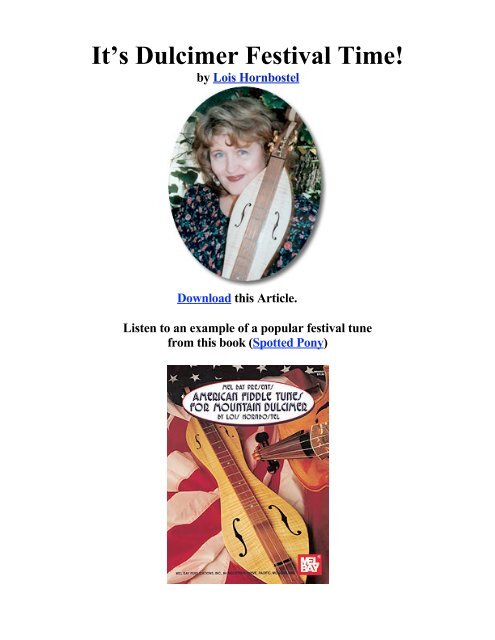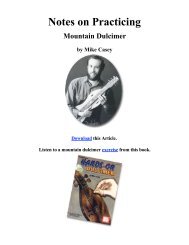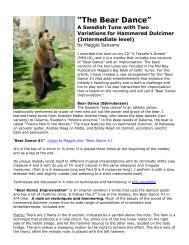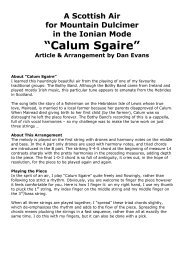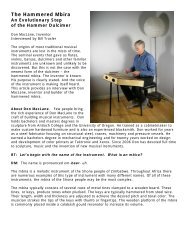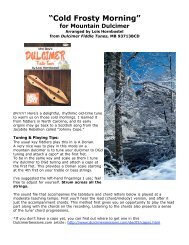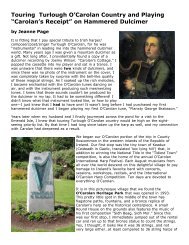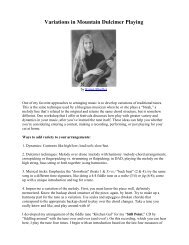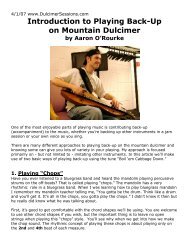It's Dulcimer Festival Time! - Mel Bay's Dulcimer Sessions
It's Dulcimer Festival Time! - Mel Bay's Dulcimer Sessions
It's Dulcimer Festival Time! - Mel Bay's Dulcimer Sessions
Create successful ePaper yourself
Turn your PDF publications into a flip-book with our unique Google optimized e-Paper software.
It’s <strong>Dulcimer</strong> <strong>Festival</strong> <strong>Time</strong>!<br />
by Lois Hornbostel<br />
Download this Article.<br />
Listen to an example of a popular festival tune<br />
from this book (Spotted Pony)
This is a special time of year when mountain dulcimer and hammered dulcimer<br />
players can feel an excitement in the air. A time to get together with other players and<br />
to recharge our creative batteries by learning new skills and beautiful music. <strong>Dulcimer</strong><br />
festivals and week-long camps are blossoming throughout the country!<br />
<strong>Dulcimer</strong> festivals attract healthy populations.<br />
One of the most characteristic elements of the “dulcimer world” is that since the<br />
1970s dulcimer festivals and camps have abounded. This has been largely due to the<br />
relative scarcity of both hammered and mountain dulcimers compared to guitars,<br />
banjos, fiddles, etc. These gatherings have provided dulcimer players with hands-on<br />
classes, beautiful music, and communication with kindred souls. <strong>Dulcimer</strong> events have<br />
made it easier to purchase and to learn to play dulcimers. Great performers, teachers<br />
and instrument builders have developed. Excellent recordings of hammered and<br />
mountain dulcimer music are available, along with instructional/repertoire books<br />
(many of which are published by <strong>Mel</strong> Bay). All of these developments have been<br />
nourished by the dulcimer events.<br />
It’s true that they happen throughout the year, but as we enter the most travel-friendly<br />
seasons we find more gatherings to visit, from Michigan to Florida and from Vermont<br />
to California. Ireland and Japan now have dulcimer festivals.
North Carolina’s Smoky Mountains are the setting for<br />
Western Carolina University Mountain <strong>Dulcimer</strong> Week, held in Cullowhee, NC.<br />
This article is not intended to be a dulcimer events calendar, but more of a history<br />
that focuses on some of the first dulcimer festivals and weeks, and how they<br />
developed and inspired more events. The <strong>Dulcimer</strong> Players News<br />
http://www.dpnews.com has complete listings of events featuring mountain and<br />
hammered dulcimers. This magazine, published by <strong>Mel</strong> Bay author Madeline<br />
MacNeil, is now in it’s 30th year and is a highly recommended resource for players<br />
of both instruments.<br />
We are using festival photos to which we have access and permission to use.<br />
We would welcome more news from other festivals, perhaps for a future article.<br />
The Cosby <strong>Dulcimer</strong> & Harp Convention was an event begun in the early 1970s<br />
in Cosby, Tennessee by folk musicians Jean and Lee Schilling. It continued until just<br />
recently, and served as a model for many other hammered and mountain dulcimer<br />
events. It was a very informal event, with primitive camping in its Smoky Mountains<br />
location, an open stage, some planned instructional workshops, potluck supper and<br />
various novelties like a watermelon spitting contest. Many dulcimer players whose<br />
names are now familiar as recording artists, luthiers and authors met there in the late<br />
1970s: Madeline MacNeil, Leo Kretzner, Ralph Lee Smith, Keith Young, Sam<br />
Rizzetta, Anna Duff, Jerry Rockwell, Alan Freeman, David Schnaufer, Jim Miller,
Alan Darveaux, and Larkin Bryant, to name a few. The Schillings were most gracious<br />
to visitors, and Lee even gave classes to aspiring artists on record production.<br />
Another important event of the same vintage is Evart, Michigan’s <strong>Dulcimer</strong><br />
Funfest, held at the Osceola County Fairgrounds. It is a large and popular event<br />
featuring mainly hammered, and some mountain dulcimer activities. For info: Donna<br />
Beckwith, 817 Innes NE, Grand Rapids, MI 49503.<br />
Around the same time, out on the West Coast, the Pacific Rim <strong>Dulcimer</strong><br />
Gathering, spearheaded by folks like Robert Force, Albert d’Ossché, Michael<br />
Rugg, Bonnie Carol and Neal Hellman, offered a weekend event that has been held<br />
at various scenic spots in the Pacific Northwest. Focusing primarily a mountain<br />
dulcimers, it included all kinds of music and instrumentation. As a result of this event,<br />
Bonnie Carol and many of the Pacific Rim musicians produced a very important early<br />
recording and book of contemporary music for mountain dulcimer entitled “The<br />
Pacific Rim Project.” The Pacific Rim Gathering still lives. For information: Robert<br />
and Jeanette Force, force@wsu.edu<br />
Back on the East Coast in 1978 Dr. Bill Spencer, who headed the Music Dept. at<br />
Appalachian State University in Boone, North Carolina, began the ASU <strong>Dulcimer</strong><br />
Playing Workshop. This week-long event focused on the mountain dulcimer, and<br />
featured traditional musicians from the area from traditional mountain dulcimer<br />
families, such as Stanley Hicks, Bob Harman, Leonard and Clifford Glenn, Edd and<br />
Nettie Presnell, and Frank Proffitt, Jr. Ralph Lee Smith, the foremost historical<br />
researcher and writer on the mountain dulcimer’s development, shared the history<br />
and traditions of the mountain dulcimer with participants. In 1987 Dr. Bill Spencer<br />
retired and asked performer/instructor Lois Hornbostel to direct the event. The years<br />
that followed included saw continued growth of this event. Focus continued on the<br />
remaining traditional dulcimer people like Jacob Ray <strong>Mel</strong>ton and the Glenns, but also<br />
presented the burgeoning developments in playing styles. In 2000, Western<br />
Carolina University’s relaxed mountain campus in Cullowhee, NC, became the site<br />
of this large, comprehensive week. For info on Western Carolina University<br />
Mountain <strong>Dulcimer</strong> Week: http://cess.wcu.edu/dulcimer<br />
The Walnut Valley <strong>Festival</strong> in Winfield, Kansas is 33 years old. While it is not a<br />
dulcimer festival, the contests it holds have provided an opportunity for hammered<br />
and mountain dulcimer players who like to participate in competitions. For info:<br />
wvfest.com
In Kentucky in the late 1970s, Anne MacFie and Dick Albin, performers working<br />
with the Kentucky Parks system, began producing numerous dulcimer events such as<br />
the late September weekend Great American <strong>Dulcimer</strong> Convention, in Pine<br />
Mountain, KY. It focused both on mountain and hammered dulcimers. In a beautiful<br />
setting visiting dulcimer players got to hear and meet in person Jean Ritchie, I. G.<br />
Stamper, and other traditional and contemporary dulcimer musicians. Anne MacFie<br />
continues to present this event in late September, along with some additional winter<br />
weekend dulcimer events. For info: http://www.pinemountainpark.com<br />
Around the same time musician Nancy Johnson Barker founded Kentucky Music<br />
Weekend, featuring performances, workshops and jams in Louisville, and the<br />
Kentucky Music Week in historic Bardstown, KY, which offers a more in-depth<br />
experience in learning mountain and hammered dulcimers and other instruments. This<br />
event thrives in a sense of musical excellence and fun that features many well-known<br />
dulcimer performers on its staff. For info: http://www.texas.net/~square1/kmw<br />
Further north, in Lima, Ohio, Dr. Susan Porter of Ohio State University began an<br />
excellent weekend event called the Great Black Swamp <strong>Dulcimer</strong> <strong>Festival</strong>. It<br />
featured hammered, mountain dulcimers and other instruments and supplied many<br />
fond memories of great music and times. After Dr. Porter’s passing the event was<br />
suspended.<br />
In West Virginia, at Davis & Elkins College, the Augusta Heritage Weeks have<br />
been influential for about 30 years in the playing of both hammered and mountain<br />
dulcimers. Augusta’s a Spring <strong>Dulcimer</strong> Week and some of Augusta’s summer<br />
“theme weeks” provide classes in both instruments. For info:<br />
http://www.augustaheritage.com<br />
Coshocton, Ohio’s Historic Roscoe Village has presented hammered and<br />
mountain dulcimer classes, performances, jamming and contests at their May event<br />
for some 30 years. For info: http://www.roscoevillage.com<br />
In the Los Angeles, California area, the Summer Solstice Folk Music, Dance &<br />
Storytelling <strong>Festival</strong> is another of the older festivals. Although not a “dulcimer”<br />
festival, it has many classes for hammered and mountain dulcimers. For info:<br />
http://www.ctms-folkmusic.org
In the Northeast, the Cranberry Gathering in Binghamton, NY, is a lively weekend<br />
featuring hammered and mountain dulcimers, and autoharp. It’s now in its 28th year.<br />
For info: http://www.cranberrydulcimer.com<br />
Also in the Northeast, the week-long Northeast <strong>Dulcimer</strong> Symposium was begun<br />
over 20 years ago by musician Barb Truex, and is continued by fellow musician<br />
David Moore. Held in Blue Mountain Lake, in upstate New York’s Adirondack<br />
Mountains, the NEDS features a small but high-quality program focusing on<br />
hammered and mountain dulcimers. For info http://nedulcimer.org<br />
We encourage mountain and hammered dulcimer players (and those who would like<br />
to learn more about the instruments and the people who play them) to expand their<br />
musical horizons and circle of friends by attending a dulcimer festival in their area.<br />
To “prepare” the new dulcimer festival visitor, we’ll finish this article with a gallery of<br />
dulcimer event photos and a favorite jam session tune, “Spotted Pony.” It’s played<br />
here at fiddle speed—faster than most of the group jams you’ll encounter!
<strong>Dulcimer</strong> <strong>Festival</strong> Photo Gallery<br />
Classes in Appalachian dulcimer history and traditional music are a popular<br />
feature, taught by expert researcher/musicians like Ralph Lee Smith, shown here<br />
with some of his vintage dulcimers held by Youth Scholars at a dulcimer week.<br />
Other instruction focuses on musicianship and more contemporary string<br />
techniques, like this one for intermediate and advanced players being taught by<br />
Larry Conger...
Staff concerts feature well-known dulcimer performers, teachers - and <strong>Mel</strong> Bay<br />
authors!<br />
Jam sessions are a popular feature of dulcimer events, both musically and socially.
George Haggerty shows how to end a tune in a jam session.<br />
Sometimes you’ll even see “trick & fancy” dulcimer playing, as <strong>Mel</strong> Bay author<br />
Neal Hellman and Robert Force demonstrate.
<strong>Festival</strong> “marketplaces” offer a variety of top-quality dulcimers like this mountain<br />
dulcimer built by Jerry Rockwell and this hammered dulcimer built by Rick<br />
Thum...
...Also available are dulcimer books, recordings and hard-to-find special dulcimer<br />
items like this mountain dulcimer-inspired jewelry made by Josie Wiseman...<br />
A Favorite Jam Session Tune: “Spotted Pony”


